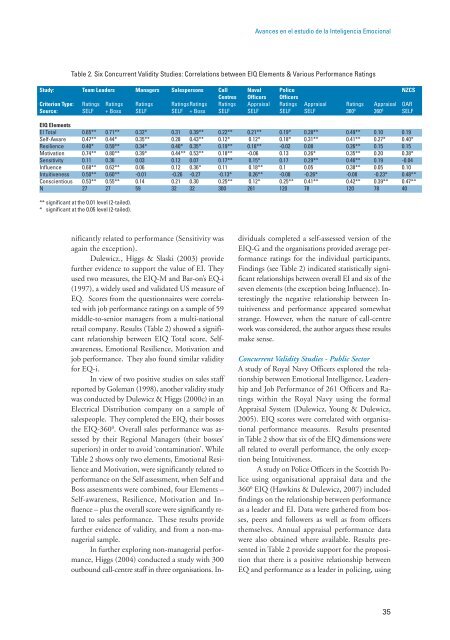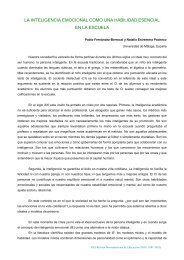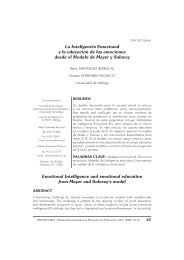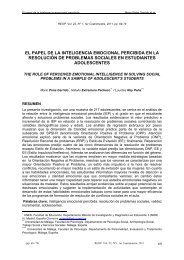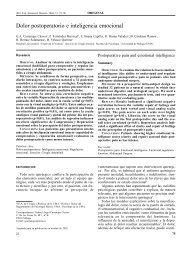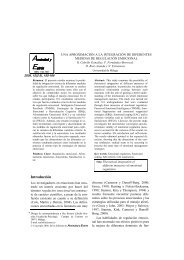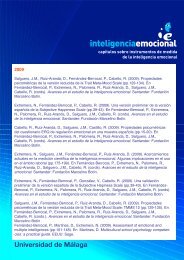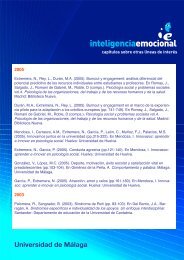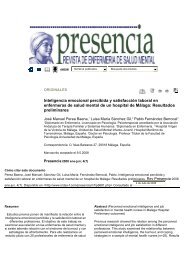Avances en el estudio de la Inteligencia Emocional
Avances en el estudio de la Inteligencia Emocional
Avances en el estudio de la Inteligencia Emocional
You also want an ePaper? Increase the reach of your titles
YUMPU automatically turns print PDFs into web optimized ePapers that Google loves.
<strong>Avances</strong> <strong>en</strong> <strong>el</strong> <strong>estudio</strong> <strong>de</strong> <strong>la</strong> Int<strong>el</strong>ig<strong>en</strong>cia <strong>Emocional</strong><br />
Table 2. Six Concurr<strong>en</strong>t Validity Studies: Corr<strong>el</strong>ations betwe<strong>en</strong> EIQ Elem<strong>en</strong>ts & Various Performance Ratings<br />
Study: Team Lea<strong>de</strong>rs Managers Salespersons Call Naval Police NZCS<br />
C<strong>en</strong>tres Officers Officers<br />
Criterion Type: Ratings Ratings Ratings RatingsRatings Ratings Appraisal Ratings Appraisal Ratings Appraisal OAR<br />
Source: SELF + Boss SELF SELF + Boss SELF SELF SELF SELF 360 0 360 0 SELF<br />
EIQ Elem<strong>en</strong>ts<br />
EI Total 0.65** 0.71** 0.32* 0.31 0.39** 0.22** 0.21** 0.19* 0.28** 0.49** 0.10 0.19<br />
S<strong>el</strong>f-Aware 0.47** 0.44* 0.35** 0.28 0.43** 0.12* 0.12* 0.18* 0.31** 0.41** 0.27* 0.40*<br />
Resili<strong>en</strong>ce 0.40* 0.59** 0.34* 0.40* 0.35* 0.19** 0.18** -0.02 0.08 0.26** 0.15 0.15<br />
Motivation 0.74** 0.80** 0.39* 0.44** 0.53** 0.18** -0.06 0.13 0.26* 0.35** 0.20 0.38*<br />
S<strong>en</strong>sitivity 0.11 0.36 0.03 0.12 0.07 0.17** 0.15* 0.17 0.29** 0.46** 0.19 -0.04<br />
Influ<strong>en</strong>ce 0.68** 0.62** 0.06 0.12 0.36* 0.11 0.18** 0.1 0.05 0.38** 0.05 0.10<br />
Intuitiv<strong>en</strong>ess 0.50** 0.60** -0.01 -0.26 -0.27 -0.13* 0.26** -0.08 -0.26* -0.08 -0.23* 0.48**<br />
Consci<strong>en</strong>tious 0.53** 0.55** 0.14 0.21 0.30 0.25** 0.12* 0.25** 0.41** 0.42** 0.39** 0.47**<br />
N 27 27 59 32 32 300 261 120 78 120 78 40<br />
** significant at the 0.01 lev<strong>el</strong> (2-tailed).<br />
* significant at the 0.05 lev<strong>el</strong> (2-tailed).<br />
nificantly r<strong>el</strong>ated to performance (S<strong>en</strong>sitivity was<br />
again the exception).<br />
Dulewicz., Higgs & S<strong>la</strong>ski (2003) provi<strong>de</strong><br />
further evid<strong>en</strong>ce to support the value of EI. They<br />
used two measures, the EIQ-M and Bar-on’s EQ-i<br />
(1997), a wid<strong>el</strong>y used and validated US measure of<br />
EQ. Scores from the questionnaires were corr<strong>el</strong>ated<br />
with job performance ratings on a sample of 59<br />
middle-to-s<strong>en</strong>ior managers from a multi-national<br />
retail company. Results (Table 2) showed a significant<br />
r<strong>el</strong>ationship betwe<strong>en</strong> EIQ Total score, S<strong>el</strong>fawar<strong>en</strong>ess,<br />
Emotional Resili<strong>en</strong>ce, Motivation and<br />
job performance. They also found simi<strong>la</strong>r validity<br />
for EQ-i.<br />
In view of two positive studies on sales staff<br />
reported by Goleman (1998), another validity study<br />
was conducted by Dulewicz & Higgs (2000c) in an<br />
Electrical Distribution company on a sample of<br />
salespeople. They completed the EIQ, their bosses<br />
the EIQ-360 0 . Overall sales performance was assessed<br />
by their Regional Managers (their bosses’<br />
superiors) in or<strong>de</strong>r to avoid ‘contamination’. While<br />
Table 2 shows only two <strong>el</strong>em<strong>en</strong>ts, Emotional Resili<strong>en</strong>ce<br />
and Motivation, were significantly r<strong>el</strong>ated to<br />
performance on the S<strong>el</strong>f assessm<strong>en</strong>t, wh<strong>en</strong> S<strong>el</strong>f and<br />
Boss assessm<strong>en</strong>ts were combined, four Elem<strong>en</strong>ts –<br />
S<strong>el</strong>f-awar<strong>en</strong>ess, Resili<strong>en</strong>ce, Motivation and Influ<strong>en</strong>ce<br />
– plus the overall score were significantly r<strong>el</strong>ated<br />
to sales performance. These results provi<strong>de</strong><br />
further evid<strong>en</strong>ce of validity, and from a non-managerial<br />
sample.<br />
In further exploring non-managerial performance,<br />
Higgs (2004) conducted a study with 300<br />
outbound call-c<strong>en</strong>tre staff in three organisations. Individuals<br />
completed a s<strong>el</strong>f-assessed version of the<br />
EIQ-G and the organisations provi<strong>de</strong>d average performance<br />
ratings for the individual participants.<br />
Findings (see Table 2) indicated statistically significant<br />
r<strong>el</strong>ationships betwe<strong>en</strong> overall EI and six of the<br />
sev<strong>en</strong> <strong>el</strong>em<strong>en</strong>ts (the exception being Influ<strong>en</strong>ce). Interestingly<br />
the negative r<strong>el</strong>ationship betwe<strong>en</strong> Intuitiv<strong>en</strong>ess<br />
and performance appeared somewhat<br />
strange. However, wh<strong>en</strong> the nature of call-c<strong>en</strong>tre<br />
work was consi<strong>de</strong>red, the author argues these results<br />
make s<strong>en</strong>se.<br />
Concurr<strong>en</strong>t Validity Studies - Public Sector<br />
A study of Royal Navy Officers explored the r<strong>el</strong>ationship<br />
betwe<strong>en</strong> Emotional Int<strong>el</strong>lig<strong>en</strong>ce, Lea<strong>de</strong>rship<br />
and Job Performance of 261 Officers and Ratings<br />
within the Royal Navy using the formal<br />
Appraisal System (Dulewicz, Young & Dulewicz,<br />
2005). EIQ scores were corr<strong>el</strong>ated with organisational<br />
performance measures. Results pres<strong>en</strong>ted<br />
in Table 2 show that six of the EIQ dim<strong>en</strong>sions were<br />
all r<strong>el</strong>ated to overall performance, the only exception<br />
being Intuitiv<strong>en</strong>ess.<br />
A study on Police Officers in the Scottish Police<br />
using organisational appraisal data and the<br />
360 0 EIQ (Hawkins & Dulewicz, 2007) inclu<strong>de</strong>d<br />
findings on the r<strong>el</strong>ationship betwe<strong>en</strong> performance<br />
as a lea<strong>de</strong>r and EI. Data were gathered from bosses,<br />
peers and followers as w<strong>el</strong>l as from officers<br />
thems<strong>el</strong>ves. Annual appraisal performance data<br />
were also obtained where avai<strong>la</strong>ble. Results pres<strong>en</strong>ted<br />
in Table 2 provi<strong>de</strong> support for the proposition<br />
that there is a positive r<strong>el</strong>ationship betwe<strong>en</strong><br />
EQ and performance as a lea<strong>de</strong>r in policing, using<br />
35


